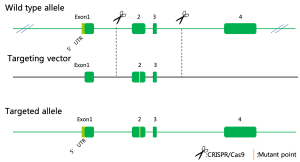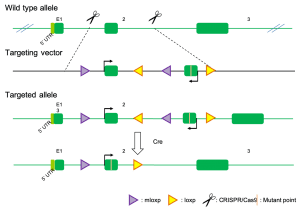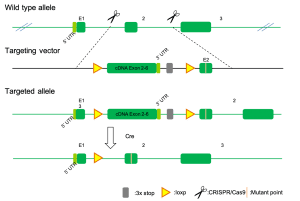Single Nucleotide Polymorphisms (SNP’s) are the most common type of naturally occurring genetic mutations, where one nucleotide or DNA base pair is replaced with another. Also known as a point mutation, SNP’s occur at a rate of 1 in every 1,000 base pairs, which means that a given individual statistically has 4 to 5 million SNP’s in their entire genome. While some point mutations are silent, others can cause phenotypic changes and in some cases disease or individual immune responses. We offer several strategies for introducing point mutations within a mouse model.
Conventional Point Mutation
A conventional point mutation mouse model is a knockin mouse line in which one or more nucleotides in the mouse genome are substituted by variant nucleotides. This can result in either an in-frame amino acid change within a given protein sequence, or a frameshift mutation. Knockin point mutation mouse models are widely used to study the roles of particular nucleotides or amino acids within proteins, which is directly applicable for studying human genetic diseases.
With intelligent use of the CRISPR/EGE system, we have developed a process in which we replace the wild-type allele with a modified targeting vector that contains the desired point mutation(s). Our gene editing experts will help you design a proper targeting vector.
Conditional Point Mutation Knockin
A conditional point mutation mouse model introduces a point mutation only when certain conditions are met. In the gene targeting strategy below, when Cre recombinase is present, a point mutation will be introduced into the mouse genome tissue specifically via Cre activity. This is done by introducing the targeting vector, containing the point mutation, along with strategic use of the Lox regions. When desired, Cre expression can be induced, which will ultimately lead to activation or transcription of the gene containing the point mutation. There are two major design strategies illustrated below.
Conditional Point KI by Double LoxP (Flex)
Conditional Point KI by Minigene
Conditional knockin mouse models could be generated using either FLEx (Flip Excision) approach (also known as dual-lox system) or Minigene system. After Cre-lox recombination by having conditional knockin mice bred with tissue specific Cre or CreERT2 mice, the mutation/reporter will be expressed in a spatial and/or temporal manner.

Request a Quote
Contact us today to find out how we can help advance your research with custom generated rat, mouse or cell line models.





